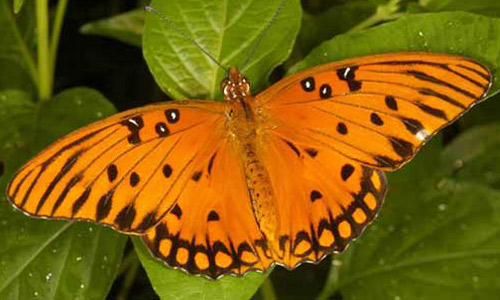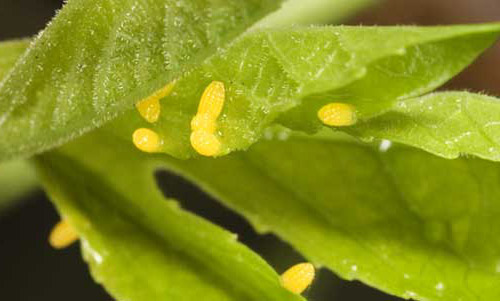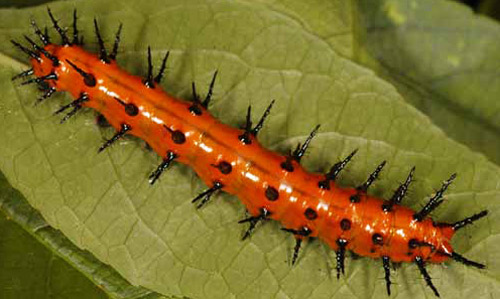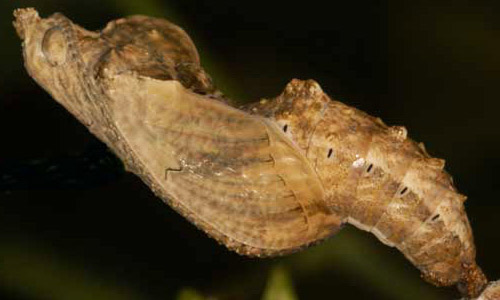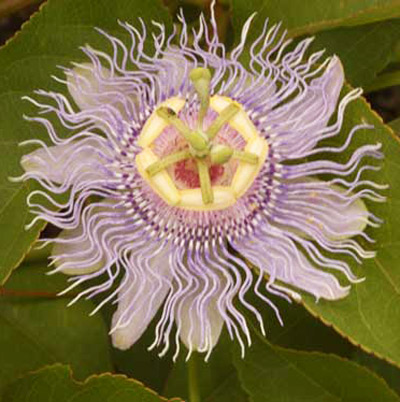common name: Gulf fritillary butterfly
scientific name: Agraulis vanillae (Linnaeus) (Insecta: Lepidoptera: Nymphalidae)
Introduction - Distribution - Description - Life Cycle and Hosts - Selected References
Introduction (Back to Top)
The Gulf fritillary, Agraulis vanillae (Linnaeus), is a brightly colored butterfly common across extreme southern portions of the United States. At home in most open, sunny habitats, it frequents roadsides, disturbed sites, fields, open woodlands, pastures, yards, and parks. It is a regular in most butterfly gardens, including those in more urban settings.
Figure 1. Adult Gulf fritillary butterfly, Agraulis vanillae Linnaeus. Photograph by Jaret C. Daniels, University of Florida.
Distribution (Back to Top)
The Gulf fritillary occurs throughout the southern United States southward through Mexico, Central America and the West Indies to South America. In Florida, it can be found in all 67 counties. The butterfly undergoes distinct seasonal movements each year. Adults move northward in spring and form temporarily breeding colonies throughout the southeast. Individual vagrants may occasionally reach into the central U.S., but rarely into the Midwest. Starting in late summer and continuing through fall, huge numbers of adults migrate southward into peninsular Florida. Adults overwinter in frost-free portions of their range.
Description (Back to Top)
Adult: The Gulf fritillary is a medium-sized butterfly with elongated forewings. Adults have a wingspan range of 65 to 95 mm. Females are generally larger than males. The sexes are dimorphic. The upper surface of the wings is bright orange with black markings. Females are somewhat darker and more extensively marked. The forewing cell contains three black-rimmed white spots. The undersides of the wings are brown with elongated silvery-white spots.
Eggs: The yellow eggs are laid singly on or near the hostplant.
Figure 2. Eggs of the Gulf fritillary butterfly, Agraulis vanillae Linnaeus, on Maypop (purple passionflower), Passiflora incarnata L. (Passifloraceae). Photograph by Jaret C. Daniels, University of Florida.
Larva: The mature larva is bright orange with numerous black branched spines.
Figure 3. Mature larvae of the Gulf fritillary butterfly, Agaulis vanillae Linnaeus, on corkystem passionflower, Passiflora suberosa L. (Passifloraceae). Photograph by Jaret C. Daniels, University of Florida.
Pupa: The pupa is mottled brown.
Figure 4. Pupa of the Gulf fritillary butterfly, Agaulis vanillae Linnaeus, on twig. Photograph by Jaret C. Daniels, University of Florida.
Life Cycle and Hosts (Back to Top)
The Gulf fritillary produces multiple generations each year. Adults may be found in all months of the year throughout much of Florida. Adults have a quick, erratic flight but are easily drawn to nearby flowers. Females lay the small yellow eggs singly on or near leaves, stems or tendrils of purple passionflower (Passiflora incarnata L.), corkystem passionflower (Passiflora suberosa L.), yellow passionflower (Passiflora lutea L.) and several other passionflower vines. The larvae are bright orange with numerous black, branched spines. Larvae may feed on all parts of the plant and can rapidly defoliate host vines. The pupa is mottled brown and resembles a dead leaf. Adults overwinter.
Figure 5. Purple passionflower, Passiflora incarnata L. (Passifloracaea), a host of the Gulf fritillary butterfly, Agraulis vanillae (Linneaus). Photograph by Jaret C. Daniels, University of Florida.
Selected References (Back to Top)
- Cech R, Tudor G. Butterflies of the East Coast: An Observer's Guide. 2005. Princeton University Press, Princeton, NJ. 345 pp.
- Daniels JC. Butterflies of Florida Field Guide. 2003. Adventure Publications, Cambridge, MN. 250 pp.
- Daniels JC. 2000. Butterflies 1: Butterflies of the Southeast. UF/IFAS. Card Set. SP 273.
- Kimball CP. 1965. The Lepidoptera of Florida; an annotated checklist. Arthropods of Florida and Neighboring Land Areas Vol. 1. Florida Department of Agriculture and Consumer Services, Division of Plant Industry. 363 pp.
- Minno MC, Butler JF, Hall DW. 2005. Florida Butterfly Caterpillars and Their Host Plants. University Press of Florida, Gainesville. 341 pp.
- Minno MC, Emmel TC. 1993. Butterflies of the Florida Keys. Scientific Publishers, Gainesville. 168 pp.
